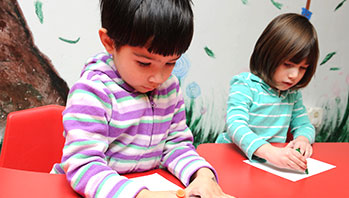- crayons
- drawing paper
- markers
- Roller Coaster (book)
MA Standards:
Writing/W.PK.MA.3: Use a combination of dictating and drawing to tell a real or imagined story.
Head Start Outcomes:
Literacy Knowledge/Early Writing: Uses scribbles, shapes, pictures, and letters to represent objects, stories, experiences, or ideas.
PreK Learning Guidelines:
English Language Arts/Composition 16: Use their own words or illustrations to describe their experiences, tell imaginative stories, or communicate information about a topic of interest.
Health Education 16: Recognize and describe or represent emotions such as happiness, surprise, anger, fear, sadness.
Draw and Write Together: We Did It!

© Commonwealth of Massachusetts, Department of Early Education and Care (Jennifer Waddell photographer). All rights reserved.
ELA Focus Skills: Concepts of Print, Drawing and Writing, Speaking and Listening
Display the spread in Roller Coaster by Marlee Frazee where the girl looks scared. Remind children that the girl was afraid, but she went ahead and rode the roller coaster.
- Talk about a time when you were afraid to do something but did it anyway and found that you liked it (singing in front of people, roller skating, etc.)
- Emphasize that sometimes it is okay to wait to try something until you are not afraid and feel more ready.
Ask children, What game, activity, or toy were you afraid to try but you felt ready and tried it anyway? How did you feel after you did it?
Children may need examples such as rode a bike, played hide and seek, slid down a slide.
- Then have children draw a picture of themselves doing the activity. Have children dictate or write their name and the activity they did at the bottom of the page.
English Language Learners: Point to illustrations in the book where the car is zipping and zooming on the roller coaster, then have children act out the action with you as you say the word to clarify the meaning. Have the child point to the action in the picture and repeat the word.
Educator Tip: If children cannot think of something they were afraid to do, ask them to tell something a friend was afraid to do. This might help them think of something in their own lives. Or, after a child gives an example, ask if other children had the same experience.
Social Emotional Tip: Discussion about overcoming fears helps children realize that talking and listening to other people is an important way to solve problems.
